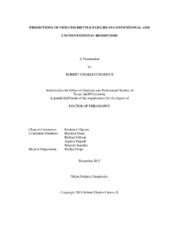| dc.description.abstract | Knowledge of the mechanical behavior of rocks is necessary to predict the response of reservoirs and basins to naturogenic and anthropogenic changes. Applications with significant economic and environmental impacts include petroleum reservoirs, geothermal systems, CO2 sequestration systems and fault behavior. This work addresses two types of poorly understood brittle failure. The behavior of rocks in tension and low mean stresses applied to hydraulic fracture in the subsurface, and the behavior of granular, porous materials in chemically reactive environments over long time periods applied to porosity development in sedimentary basins and petroleum withdrawal or CO2 injections in reservoirs.
The behavior of an induced hydraulic fracture is difficult to predict a priori due to great uncertainty in fracture geometry, kinematics, and induced damage as a function of stress state. Previous experiments have shown that the conventional failure criteria for tensile and low mean stresses are inadequate. Experiments were conducted on four rock types with different mechanical properties and mineralogic compositions: Berea sandstone, Carrara marble, Indiana limestone, and Kansas chalk. The results are used to develop a universal failure criterion for low mean stress states occurring in hydraulic fracturing and other high-fluid pressure regimes. The criterion defines mechanical properties as well as fracture characteristics as a function of stress state. The failure criterion may be easily applied to all rock types as it scales with the uniaxial extensional strength of the rock.
The consolidation of porous, granular materials occurs at strain rates as low as 10^-9 and 10^-15 seconds^-1 for reservoirs and sedimentary basins. Previous work has shown fluid saturated granular materials, such as quartz sand in water, consolidate with time by subcritical crack processes. Consolidation experiments and creep experiments were conducted on quartz sand to test the applicability of soil mechanics principles to time-dependent consolidation of granular porous rock. Results show that the effect of strain rate and temperature can be used in the framework of parallel lines of consolidation to predict the critical pressure for crushing, P*, for quartz sand at in situ conditions. Accordingly, consolidation of rocks can be predicted because shear-enhanced compaction depends on P*. | en |


